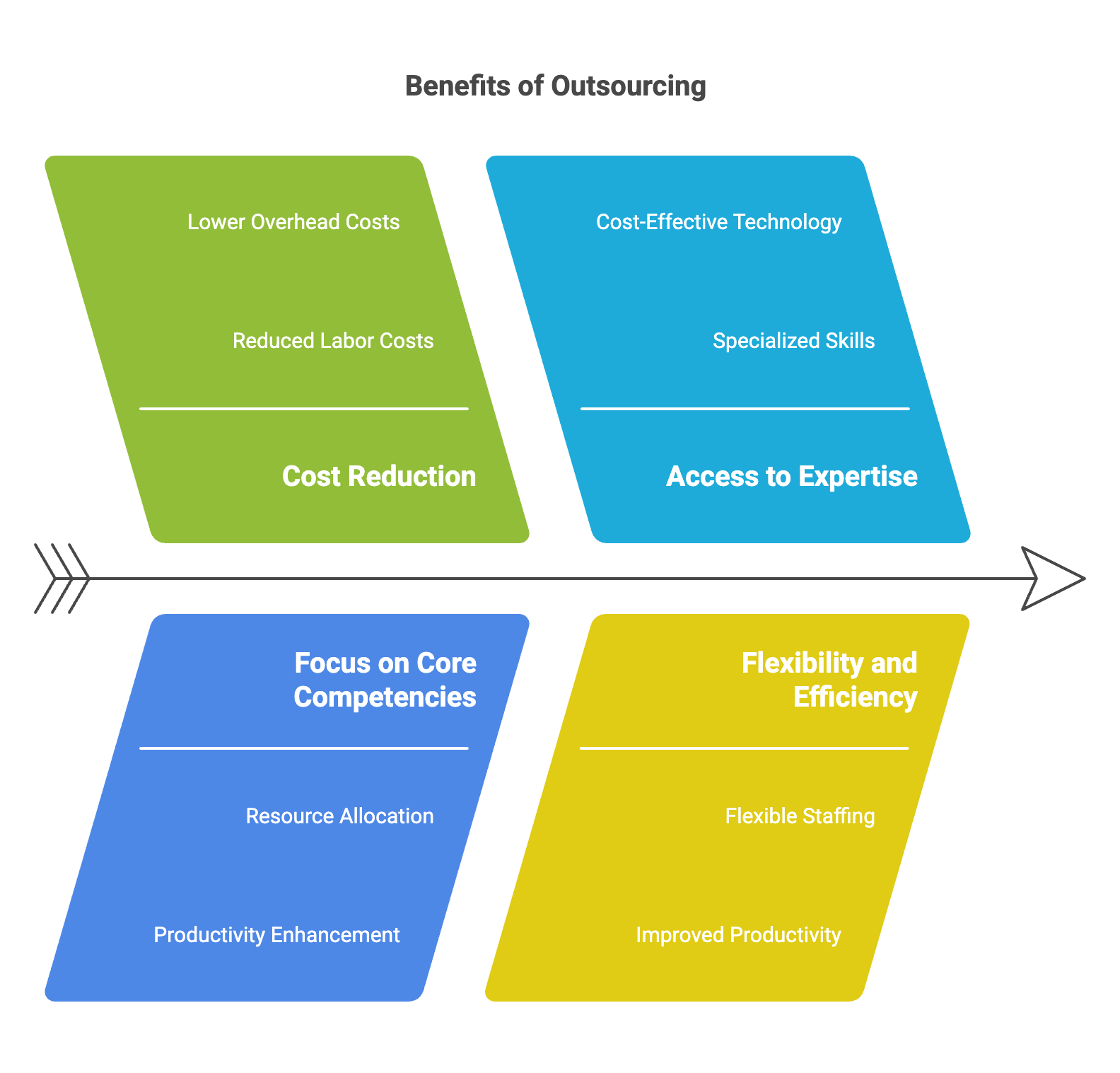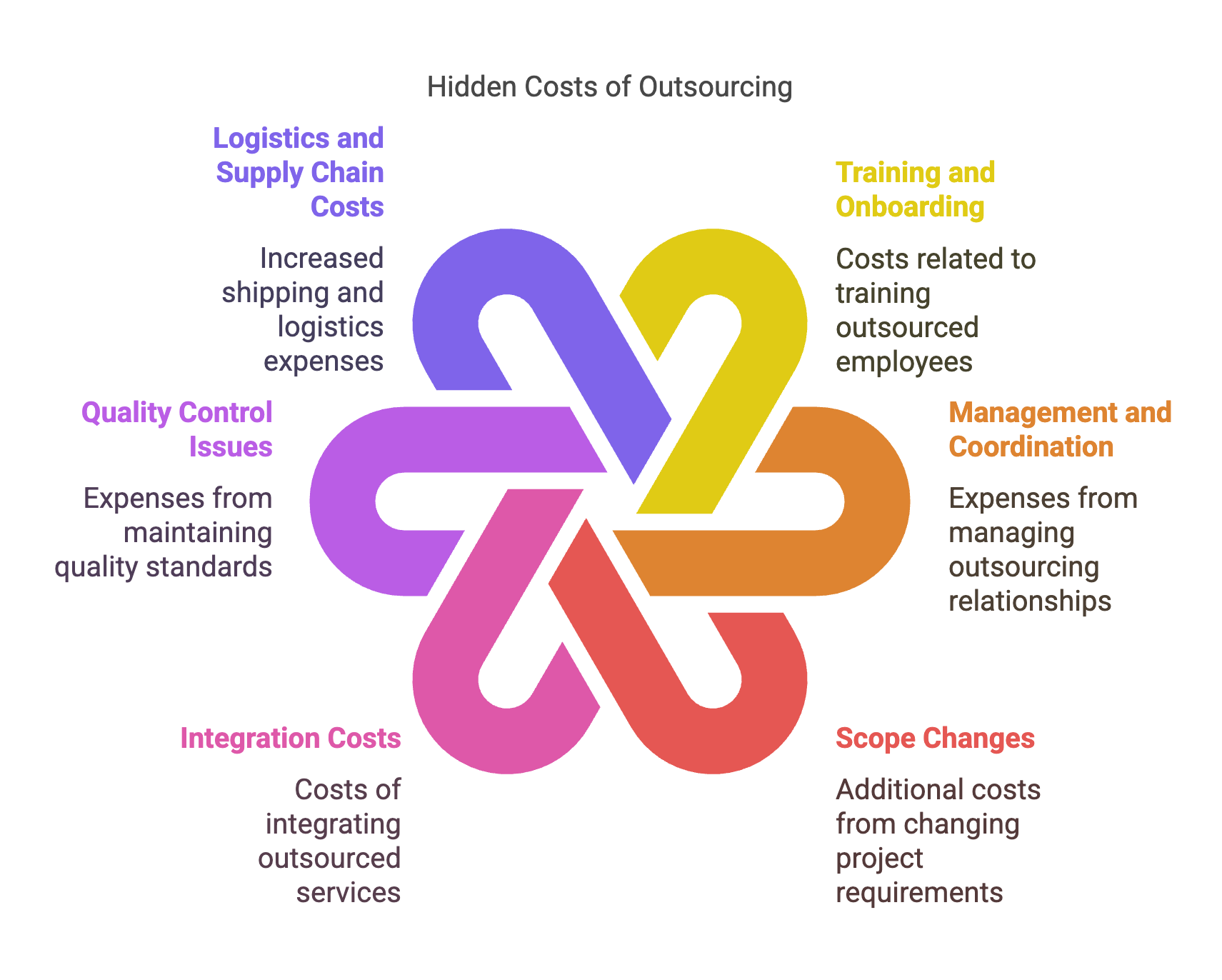Businesses decide to outsource for several key reasons, but cost reduction is a primary driver. Outsourcing can significantly reduce labor and operational costs by eliminating the need to hire, train, and retain a large in-house team. Other reasons include accessing specialized expertise, focusing on core competencies, enhancing scalability and flexibility, improving customer service, and optimizing resource allocation.
In the U.S., roughly 300,000 jobs are outsourced annually. IT services, customer service, marketing, HR, finance, and administration are among the most commonly outsourced departments. The reason why so many businesses outsource their work is to have access to global talent pools while reducing hiring costs significantly.
So, how much does outsourcing cost? The shortest answer would be that it depends on the type of work you want to outsource. For example, outsourcing HR tasks can save companies an average of 22%, while the typical cost per recruit in the tech industry can range from $4,000 to $20,000.
With Go Carpathian, business owners can save a significant amount of money on outsourcing. The savings will depend on the specific role and the experience needed. Schedule a call with a recruitment specialist today to get a quote suited to your specific needs!
In this article, we will explain what is outsourcing, what are the main benefits of outsourcing, what factors impact the cost of outsourcing, and how to calculate the cost of outsourcing.
What Is Outsourcing
Outsourcing is a business practice in which companies delegate specific tasks, functions, or services to external providers rather than managing them internally. This can include a wide range of activities, such as customer service, IT support, manufacturing, and human resources. By outsourcing, businesses can benefit from cost savings, access to specialized expertise, increased efficiency, and the ability to focus on their core competencies. This approach allows companies to scale operations more flexibly and often leads to improved service quality and innovation by leveraging the strengths of specialized firms or professionals.
8 Benefits of Outsourcing
Yes, outsourcing can significantly reduce costs for businesses in different ways, especially when it comes to lowering hiring costs. Here are 8 ways outsourcing can benefit your business:
1. Reduced Labor Costs
Outsourcing can drastically cut labor expenses. Professional outsourcing agencies like Go Carpathian can match businesses with quality hires from Eastern Europe, South Africa, and Latin America. Hiring costs in these regions are significantly lower compared to the Western countries.
2. More Focus on Core Competencies
By delegating non-core functions to external providers, business owners can concentrate on their core business activities. This allows for better resource allocation to essential activities, enhancing productivity and financial outcomes.
3. Access to Expertise
Outsourcing provides access to specialized skills without the need to hire full-time staff. Hiring a professional team offshore can be more cost-effective than maintaining an in-house team.
4. Flexible Staffing
Outsourcing enables flexible staffing solutions, allowing businesses to adjust to changing demands without incurring costs related to hiring or layoffs. Outsourced services can be scaled up or down as needed, saving money on labor costs.
5. Lower Overhead Costs
Outsourcing can decrease the need for office space and equipment, which reduces expenses on rent, utilities, and maintenance. Instead of paying for overhead for new employees, companies can rely on the outsourcing provider to manage those costs.
6. No Hiring, Training, or Retention Costs
Outsourcing eliminates expenses related to hiring, onboarding, and training employees. It also reduces costs associated with employee benefits, software licenses, and other employee-related expenses. Hiring an employee can cost far more than outsourcing the same work.
7. Access to Cost-Effective Technology
Service providers often invest in the latest tools and systems, allowing businesses to benefit from modern technology without the upfront costs.
8. Improved Efficiency and Productivity
Specialization by outsourcing providers enables faster task completion and better service delivery. Regular performance checks and continuous improvement further cut costs and boost efficiency. On average, businesses can save between 20% to 30% of their operational costs when they choose to outsource functions. In 2018, 62% of companies reported 10% to 25% savings when they outsourced, and 38% reported savings as high as 40%.
Key Factors That Impact Outsourcing Cost
Several key factors impact the cost of outsourcing, influencing both direct and indirect expenses. Here are the primary considerations:
Location
The geographical location of the outsourcing provider plays a crucial role in determining labor costs. Countries with lower wages can offer significant savings compared to domestic hiring, but this must be balanced with potential quality and communication challenges.
With Go Carpathian, business owners can outsource to Eastern Europe, South Africa, and Latin America. Outsourcing to Latin America, South Africa, and Eastern Europe is generally less expensive than in Western countries due to significantly lower labor costs driven by regional economic conditions and wage structures.
- Latin America: The average cost for outsourcing software development ranges from $30 to $50 per hour, about 50% lower than average salaries in North America and Western Europe, where costs can reach approximately $182 per hour.
- South Africa: Outsourcing costs here range from $20 to $40 per hour, making it a cost-effective option compared to Western rates.
- Eastern Europe: The average hourly rate is between $30 and $66, which is still considerably lower than the $149 per hour typically charged in Western Europe.
Scope and Complexity of Work
The nature of outsourced tasks affects costs. More complex projects may require specialized skills, leading to higher fees. Additionally, the clarity of project scope can influence pricing models, such as fixed-price versus time-and-materials contracts.
Company Size and Needs
Larger companies may have more complex requirements that could lead to higher outsourcing costs, while smaller businesses might find outsourcing more cost-effective due to fewer overheads.
Hidden Costs of Outsourcing
These include expenses not immediately apparent, such as training for the outsourced team, integration with existing processes, and potential quality control issues. Hidden costs can erode expected savings if not carefully managed.
Key hidden costs include:
- Training and Onboarding: Additional time and resources may be required to train outsourced employees on specific business processes, which can delay productivity and incur extra costs. Go Carpathian helps businesses by providing support during the onboarding of new hires to ensure seamless integration.
- Management and Coordination: The cost of managing the relationship with the outsourcing provider, including travel expenses and time spent on communication, can add up quickly.
- Scope Changes: If project requirements change or expand beyond the initial agreement, this can lead to unanticipated expenses as vendors may charge for additional work not covered in the original contract.
- Integration Costs: Integrating outsourced services with existing internal systems may require additional meetings, adjustments, and technological investments, impacting overall costs.
- Quality Control Issues: Maintaining quality standards can lead to increased costs if additional oversight or corrections are needed due to performance issues with the outsourced team.
- Logistics and Supply Chain Costs: Outsourcing can complicate logistics, leading to increased shipping expenses or delays that require expedited shipping solutions.
- Cash Flow Implications: The complexity of managing multiple outsourcing relationships can lengthen cash-to-cash cycles, impacting overall cash flow.
How to Calculate Outsourcing Cost?
Outsourcing costs can be calculated through a structured four-step process that helps businesses assess the financial implications of delegating tasks to external providers. Here’s a detailed explanation of each step:
1. Define What You Want to Outsource
Begin by clearly identifying the specific business processes or functions you want to outsource. This involves understanding all workflow steps and ensuring that the scope is well-defined. A precise definition helps in accurately calculating existing in-house costs and provides potential outsourcing providers with a reliable brief for quoting their services.
2. Calculate Avoidable In-House Costs
Next, itemize all costs associated with the in-house process, including direct costs (salaries, equipment, supplies) and indirect costs (administration, internal services). It’s crucial to focus on avoidable future costs rather than sunk costs, which are unrecoverable expenses already incurred. This step helps identify which costs could potentially be eliminated or reduced if the process is outsourced.
3. Determine Total Outsourcing Costs
After calculating in-house costs, gather quotes from outsourcing providers based on the defined process. The total outsourcing costs should include the provider’s bid price, contract administration costs, and any transition expenses incurred during the switch to outsourcing. Additionally, consider any potential revenue from selling unneeded assets or resources that can be redirected to more profitable areas of the business.
4. Calculate Cost Savings
Finally, subtract the total outsourcing costs from the avoidable in-house costs to determine potential savings. This calculation will indicate whether outsourcing offers a cost advantage significant enough to justify proceeding with the outsourcing decision. The formula for calculating savings can be expressed as:
Need a Partner in Understanding Outsourcing Cost?
Outsourcing offers businesses significant benefits, with cost reduction being the most prominent. By delegating tasks to external providers, companies can save on labor costs, overhead, and operational expenses. It also allows businesses to focus on core competencies, access specialized talent, improve efficiency, and scale operations flexibly without the long-term commitment of hiring full-time staff. Additionally, outsourcing often drives innovation by leveraging the expertise and advanced technologies of external providers.
With Go Carpathian, you can outsource your work to Eastern Europe, South Africa, and Latin America. These regions offer lower hiring costs and quality professionals, which is a real win-win for business owners. Go Carpathian can help you find the best, pre-vetted hires from these regions and offer you support throughout onboarding.






